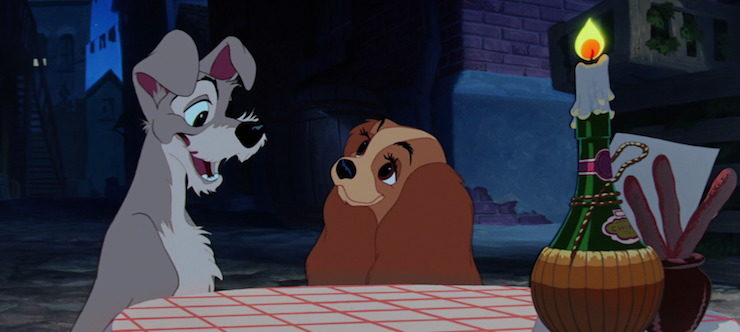Walt Disney started the 1950s in a delighted mood. Cinderella wasn’t just a hit—it was doing so well that he finally had funds to start up his next dream project, a little thing he called Disneyland. And possibly start shifting his movie studio towards making live action films, since the joint cartoon/live action experiments had, for the most part, done decently at the box office.
Alas, the films that immediately followed Cinderella did not do quite as well at the box office. This wasn’t just the usual revenue problem: Walt Disney needed a film to keep up the interest in his company and build the Disney brand as he started to build Disneyland. Disney did have another animated film in production, the lavishly animated Sleeping Beauty, but for multiple reasons, that film was mired in production delays. Disney needed a new animated film relatively quickly—something easy to animate, with clear popular appeal. Those little mice had unexpectedly become the showstoppers of Cinderella, and Disney had generally—Bambi aside—done well with cartoon animals. Why not something about dogs?
Like most of the Disney animated films of the 1950s, this was not a new idea. Animators had been toying since the mid-1930s with the concept of a film centered around a dog called Lady, very loosely based on an English cocker spaniel owned by Disney artist Joe Grant, and a moment from Walt Disney’s own life, when he had decided to apologize to his wife by giving her a puppy in a hat box. Unfortunately, however adorable, Joe Grant’s dog and a hat box were not quite enough plot for a full length feature. Still mulling over the concept, Walt Disney read a story in Cosmopolitan that had a dog character he could work with, and bought the rights to the story. (This would be the story I was unable to track down for the Disney Read-Watch.) By then, however, war had broken out in Europe, impacting the Disney studio, and forcing the still sketchy dog film to be set aside for several years.
Sidenote: Joe Grant ended up leaving Disney before Lady and the Tramp went into production, but would later return right before the Disney Renaissance of the 1990s, as one of the artists who helped restore the studio to its greatness, and continue to draw for the studio right up until the day of his death in 2005 at the age of 96. It was a lovely coda both for his career and for the company that helped immortalize his dog.

Now that it was back into production, Walt Disney made several decisions. First, to distinguish the film from its three predecessors, and once again showcase the potential range of Disney animation, Walt Disney announced that for this film, animators would need to draw realistic looking dogs, not mere cartoons. He also ordered the film to remain at the eye level of a dog whenever possible, creating issues of perspective for both background artists and animators. Which is to say, if you’ve ever wondered why Darling’s hair is a different color every time it appears on screen—well, it appears on screen so rarely that apparently no one thought of deciding on a color for it. Second, Walt Disney decided that Lady and the Tramp would be filmed with CinemaScope, 20th Century Fox’s latest innovation, first used in their 1953 Biblical drama The Robe.
For technically minded people, CinemaScope represents a major development in cinematography, featuring a lens developed by Bausch & Lomb that could create films in a 2:66:1 aspect ratio, initially squeezing the image before expanding it during projection, allowing film directors to dramatically change the composition of shots. It also allowed studios to add stereo sound to their films, a technological jump that would eventually lead to home sound surround systems. For less technically minded people, like me, CinemaScope was the first appearance of what we now call “widescreen,” signaling the start of major changes in the overall film industry. Apart from various technical advantages, CinemaScope provided an immediate advantage to film studios: it ensured that films viewed in the theatre would have a different “look” than anything viewed on a still new and exciting medium moving into U.S. households: television.
Unlike 20th Century Fox executives, Walt Disney was not particularly worried about television, correctly foreseeing the new medium as something that would eventually benefit his company. But he could not resist the opportunity to play with a new technology. Anything that allowed innovation with a soundtrack was bound to interest a man who had created a new sound system for a single film, but Disney was also fascinated by the animation potential offered by the widescreen format.
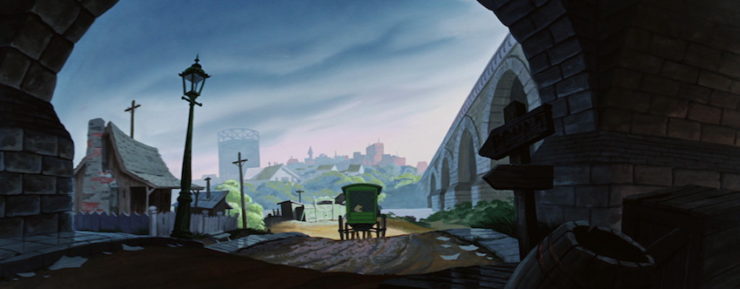
The artists working on Lady and the Tramp had only one objection, but it was a major one: they had already finished designing the film to fit the non-widescreen ratio, and now had to figure out how to move all of their little animated figures across a much wider screen and redesign some of the backgrounds. As they worked on accomplishing this, Walt Disney threw them another bombshell: several theatres—many harboring unkind feelings about 20th Century Fox—would not have projectors capable of showing CinemaScope. Thus, the animators would have to finish two versions of the film using both aspect ratios in the time frame budgeted for just one version.
Incredibly, most of the artists did not immediately quit.
It’s possible that they just liked dogs, or their work. Or it’s possible that by that time, they realized that in Lady and the Tramp, they had something new for Disney on their hands: a genuine romance. About half of the Disney films had no romance at all. The Prince Charmings of both Snow White and Cinderella and the centaurs of Fantasia had been such ciphers that they hardly counted as romances, and the less said about the animal hookups in Bambi the better.
In contrast, Lady and the Tramp follows all of the beats of a traditional romance, introducing two dogs from very different backgrounds, who meet, have an immediate misunderstanding, adventures, a romantic night out on the stars complete with spaghetti, meatballs and a singing chef, and more adventures before finally joining forces to take down an evil rat. Incidentally, in another change from many Disney films, the rat is the closest thing Lady and the Tramp has to a major villain. Oh, minor villains—the Siamese cats, the dog catchers at the pound, the mean dogs who terrorize Lady, the rat—abound, but no major ones. Not even Aunt Sarah, who puts a muzzle on poor Lady and later ties her up to the doghouse, since she’s not exactly a villain. She just misunderstands the situation, getting tricked by her cats and a rat. And not even the dog catcher who runs down and kills Trusty the dog—largely because, as small horrified viewers soon learn, Trusty is not dead yet. Indeed, he’s getting better.
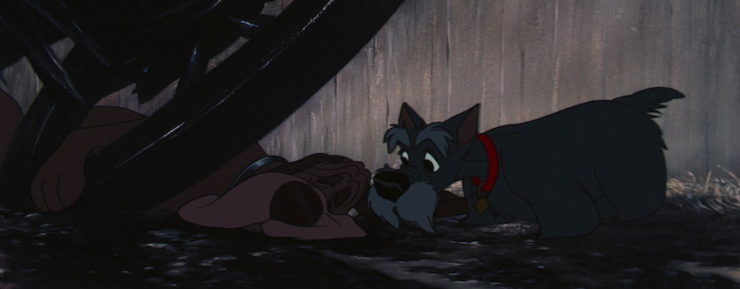
That was a last minute change made by Walt Disney, still smarting over the negative reception to the death of Bambi’s mother just a little over a decade earlier. This death, he decided, was even worse—we never do see the body of Bambi’s mother, but Trusty is right there, beneath the wagon wheels, not moving, while Jock howls beside him. It’s a jolting moment in an otherwise fairly quiet film, but having Trusty make an appearance just moments later is not really all that much better. Sure, Snow White had previously “died” and returned to life—but that was in a fairy tale, not in a—mostly—realistic depiction of dogs.
It’s probably worth noting that the dog who dies mostly offscreen—Nutsy—stays dead.
But back to the romance. Lady and Tramp, as their names suggest, aren’t just from two different worlds, but have very different personalities. Lady is so sheltered, and so young, that she knows almost nothing about life beyond her family and her fence. She even has to be told about babies. Tramp has had so many hard knocks that he’s turned into a cynic, especially about babies. But Lady learns quickly, and Tramp mellows quickly. Possibly the best part of their romance is how much they improve each other, with Tramp expanding Lady’s horizons, and Lady teaching Tramp responsibility.
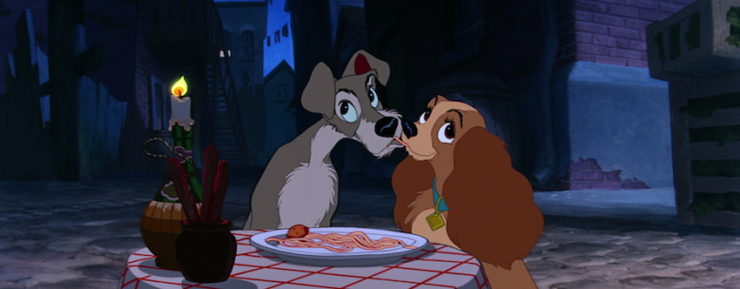
The second best part of their romance is, of course, their legendary scene with spaghetti and meatballs, so legendary that I was braced for it to be completely awful. It turns out, however, to be genuinely sweet, with the accordion music just barely preventing it from being too syrupy. I mean, Tramp gives Lady the very last meatball. That, everyone, is true love. Even if he does completely blow it the very next morning by convincing Lady to try something that she really doesn’t want to do—chase chickens—something that leads her into danger.
A few things about the film have not dated all that well—most notably the decision to give pretty much every dog some sort of ethnic identity, followed by the decision to leave the Russian and the Mexican dogs in the pound along with the streetwalking and other doomed dogs, while the American, American South and Scottish dogs enjoy a luxurious life in gated mansions.
And the decision to have the mean Siamese cats speak in vaguely Chinese accents, though I ended up having slightly mixed feelings on this. On the one hand, having the American voiced dog bravely try to save the goldfish and the baby from malicious Siamese cats who sing a song meant to be vaguely reminiscent of Chinese music is….well, it’s not great, let’s start there. On the other hand, I spent years sharing a home with a cat who took positive delight in swiping things off shelves despite being told in no uncertain terms that said things belonged on shelves, and another cat who, as the superior lifeform on the planet, apparently felt that tormenting lower forms of life, which included, but was not limited to, dogs, was part of her job. That is, these Siamese cats are, well, cats, and if their song had been voiced in pretty much any other accent, and given any other melody, I’d be applauding the realism. Unfortunately, however, they are speaking in vaguely Chinese accents.
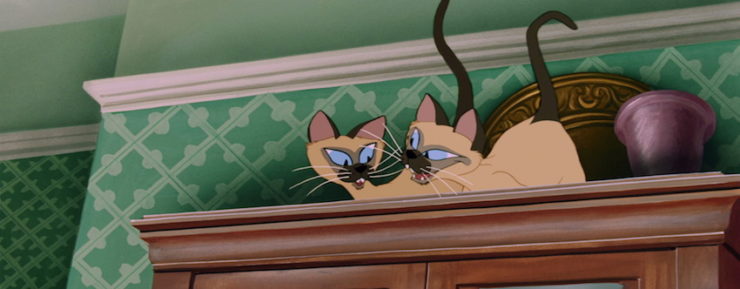
And speaking of realism, in my experience, at least, dogs love their people—sometimes a little too much—and thus, Tramp’s delight at finding a home and people feels genuine. And certainly, after risking his life and freedom to kill a rat, he deserves some reward. But I also can’t help feeling a little sorry to see the freedom loving Tramp, who dreamed of adventure and seeing the world, wily enough to turn almost every human into a friend (except the dogcatcher) transformed into a licensed, stay at home dog.
But it does fit the main message of the film, which is, perhaps not surprisingly for a 1950s film, a conservative message that deeply stresses the importance of turning away from adventure for the comforts of home. It’s not just with the dogs, either. Jim and Darling’s little baby is perfectly safe right up until the moment the couple takes off, with Darling feeling that the little baby is just too little to be left alone, even with guardians like Aunt Sarah and Lady.
Sure enough, not only does this lead to a pretty terrifying experience for poor Lady, but as a result of that experience, the baby is almost—almost—eaten by a rat, since Lady, chained outside, can’t stop the rat. I suppose we could argue that, in a way, the baby is also saved because Jim and Darling took off. After all, their departure led to Lady running away from Aunt Sarah, which led to Lady meeting up with Tramp again, which led to Tramp hanging around the house, ready and able to rescue helpless babies from rats at a bark’s notice. But not only is Lady perfectly capable of stopping a rat without Tramp’s help—as long as she’s not chained up—Tramp and Lady had met well before this. I think it’s very safe to say that Tramp might have been meandering about, ready to rescue babies and impress Lady, even if Jim and Darling had never left their house, and equally safe to say that the film, at least, strongly believes that everyone would have been safer had Jim and Darling stayed at home.
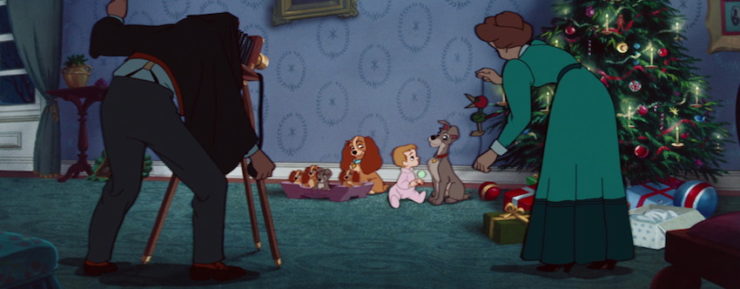
To slightly counter this, in at least one case, when Lady and Tramp sneak into the zoo to get her muzzle removed, breaking the law turns out well. And their wandering the streets without a leash does lead to a night of romance and spaghetti. But it also leads to terrifying, humiliating moments for Lady, as she learns what happens to dogs without licenses. Spoiler: they get dragged away off screen to die. Trying to prevent an unlicensed dog from that same fate leads directly to Trusty’s not-actually-a-death. Meanwhile, whatever my feelings about Tramp and freedom, it only takes Tramp a few months at most to accept the comforts of home and puppies, in a message repeated again and again in the film. The dogs who have homes and licenses take pride in them; the dogs without homes long for licenses. Darling and Jim Dear are happiest at home.
The film itself drips in nostalgia: this is not the 1950s, but some earlier, unspecified period right before World War I, judging by the glimpses of clothing and technology, a period that Walt Disney remembered with fondness. It might not be easy for everyone, as the dogs in the pound point out, but for dogs—or people—who obey the rules, remember their duties, and stay at home, it’s happy.
Whether it was the nostalgia, or the romance, or simply the adorable dogs, Lady and the Tramp was a hit, managing to outperform both Cinderella and Snow White at the box office, and continuing to earn money on subsequent releases. Decades later, Disney capitalized—or tried to capitalize—on nostalgia for the film by producing an atrocious sequel, Lady and the Tramp II: Scamp’s Adventure. Long term, merchandise—including art based on the film as well as the ubiquitous plush toys, clothing and Disney trading pins—proved even more profitable. Disney never managed to find a way to turn Lady and the Tramp into a theme park ride, and the realistically drawn characters never appear at Character Meet and Greets. But Lady and Tramp’s romantic spaghetti dinner could and did get referenced at various Disney restaurants and occasionally at the Epcot Food and Wine Festival. It remains one of Disney’s most classic and successful films.
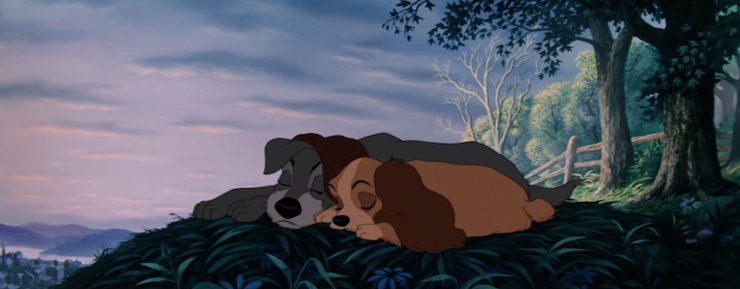
Next up, a film that was not quite as successful, at the time or later: The Aristocats.
Mari Ness lives in central Florida.










